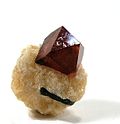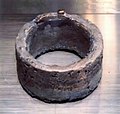Naturally occurring zirconium (40Zr) is composed of four stable isotopes (of which one may in the future be found radioactive), and one very long-lived...
19 KB (1,564 words) - 00:43, 16 August 2024
Five isotopes occur naturally, four of which are stable. The metal and its alloys are mainly used as a refractory and opacifier; pure zirconium plays...
48 KB (5,378 words) - 23:18, 7 September 2024
All unstable isotopes of molybdenum decay into isotopes of zirconium, niobium, technetium, and ruthenium. Molybdenum-100, with a half-life of approximately...
20 KB (1,313 words) - 03:53, 6 September 2024
Stable nuclide (redirect from Observationally stable isotope)
elements, they are usually termed stable isotopes. The 80 elements with one or more stable isotopes comprise a total of 251 nuclides that have not been known...
28 KB (3,270 words) - 05:48, 14 September 2024
Hafnium (redirect from History of hafnium)
nuclei of several different hafnium isotopes readily absorb two or more neutrons apiece. In contrast with this, zirconium is practically transparent to thermal...
47 KB (5,395 words) - 15:56, 11 September 2024
Moon (redirect from Moon of the Earth)
acquiring a significant amount of the proto-earth are more difficult to reconcile with geochemical data for the isotopes of zirconium, oxygen, silicon, and other...
268 KB (25,978 words) - 13:33, 12 September 2024
Fission products (by element) (redirect from List of fission products)
However, a small share of this zirconium does capture neutrons and contributes to the overall inventory of radioactive zirconium isotopes. Zircalloy cladding...
34 KB (4,505 words) - 23:54, 9 July 2024
many β− decays to beta-stable isotopes of higher-numbered elements. The absorption neutron cross section of an isotope of a chemical element is the effective...
8 KB (927 words) - 01:52, 13 July 2024
(93Zr) isotopes of the preceding element zirconium from production via beta decay of neutron-rich fission fragments. 95Nb is the decay product of 95Zr (64...
19 KB (1,041 words) - 16:07, 10 September 2024
This is a list of radioactive nuclides (sometimes also called isotopes), ordered by half-life from shortest to longest, in seconds, minutes, hours, days...
69 KB (284 words) - 17:38, 25 August 2024
11 have 5 stable isotopes, 9 have 4 stable isotopes, 5 have 3 stable isotopes, 16 have 2 stable isotopes, and 26 have 1 stable isotope. Additionally, about...
37 KB (2,204 words) - 17:11, 25 March 2024
Zircon (redirect from Zirconium orthosilicate)
mineral belonging to the group of nesosilicates and is a source of the metal zirconium. Its chemical name is zirconium(IV) silicate, and its corresponding...
30 KB (3,036 words) - 21:19, 23 August 2024
half-life isotopes provide most of the heat and radioactive decay, with the curve of decay heat being a sum of the decay curves of numerous isotopes of elements...
45 KB (5,711 words) - 16:47, 1 April 2024
Atomic mass (redirect from Isotopic mass)
the heavy isotopes, with increasing atomic number. This corresponds to the fact that nuclear fission in an element heavier than zirconium produces energy...
21 KB (2,713 words) - 15:58, 25 August 2024
Nuclear fallout effects on an ecosystem (category Aftermath of war)
reactor, and attached to these particles were Cerium, Zirconium, Lanthanum, and Strontium. All of these elements have low volatility, meaning they prefer...
12 KB (1,348 words) - 23:34, 20 July 2024
Natural nuclear fission reactor (category Geography of Gabon)
access to the isotopic composition of neodymium produced by the fission of 235 U . The two isotopes 143 Nd and 145 Nd lead to the formation of 144 Nd and...
21 KB (2,577 words) - 18:57, 8 September 2024
Rutherfordium (redirect from History of rutherfordium)
experiments from hydrochloric acid solutions using isotopes of rutherfordium, hafnium, zirconium, as well as the pseudo-group 4 element thorium have...
48 KB (7,926 words) - 23:20, 21 August 2024
Technetium (redirect from Discovery of technetium)
element whose isotopes are all radioactive. Technetium and promethium are the only radioactive elements whose neighbours in the sense of atomic number...
67 KB (7,664 words) - 03:05, 14 September 2024
Chemical element (redirect from History of chemical elements)
isotope. Except for the isotopes of hydrogen (which differ greatly from each other in relative mass—enough to cause chemical effects), the isotopes of...
74 KB (9,731 words) - 02:41, 13 September 2024
and zirconium form stable chemical compounds called metal hydrides when combined with hydrogen or its isotopes. These metal hydrides are made up of two...
21 KB (2,711 words) - 20:02, 9 February 2024
Titanium (redirect from Applications of titanium and titanium alloys)
a second. The isotopes of titanium range in atomic weight from 39.002 u (39Ti) to 63.999 u (64Ti). The primary decay mode for isotopes lighter than 46Ti...
79 KB (8,788 words) - 08:10, 13 August 2024
Thorium (redirect from History of thorium)
All known thorium isotopes are unstable. The most stable isotope, 232Th, has a half-life of 14.05 billion years, or about the age of the universe; it decays...
136 KB (15,975 words) - 05:51, 18 August 2024
Tin (redirect from Compounds of tin)
have to go through isotopic separation to remove the isotopes with odd mass number. Combined, these three isotopes make up about 17% of natural tin but represent...
80 KB (8,912 words) - 22:06, 14 September 2024
Plutonium (redirect from History of plutonium)
to power some spacecraft. Plutonium isotopes are expensive and inconvenient to separate, so particular isotopes are usually manufactured in specialized...
139 KB (14,903 words) - 22:49, 12 September 2024
Calcium (redirect from Compounds of calcium)
days) and 47Ca (half-life 4.54 days). Isotopes lighter than 42Ca usually undergo beta plus decay to isotopes of potassium, and those heavier than 44Ca...
47 KB (5,901 words) - 03:24, 8 September 2024
Yttrium (redirect from History of yttrium)
(Z = 38) isotopes. Yttrium isotopes with mass numbers at or above 90 decay primarily by electron emission (neutron → proton) to form zirconium (Z = 40)...
58 KB (6,666 words) - 08:13, 6 August 2024
Nihonium (redirect from History of nihonium)
of 282113 were detected. The aim of this experiment had been to synthesise the isotopes 281113 and 282113 that would fill in the gap between isotopes...
91 KB (13,641 words) - 22:53, 21 August 2024
Oganesson (redirect from History of oganesson)
aimed at a mixed-isotope californium target containing 249Cf, 250Cf, and 251Cf, with the aim of producing the heavier oganesson isotopes 295Og and 296Og...
63 KB (10,409 words) - 21:29, 22 August 2024
Astatine (redirect from History of astatine)
all its isotopes have half-lives of 8.1 hours or less, decaying into other astatine isotopes, bismuth, polonium, or radon. Most of its isotopes are very...
82 KB (9,309 words) - 00:35, 27 August 2024
Period 5 element (section Zirconium)
compounds such as zirconium dioxide and zirconocene dichloride, respectively. Five isotopes occur naturally, three of which are stable. Zirconium compounds have...
42 KB (4,989 words) - 03:33, 15 April 2024


















